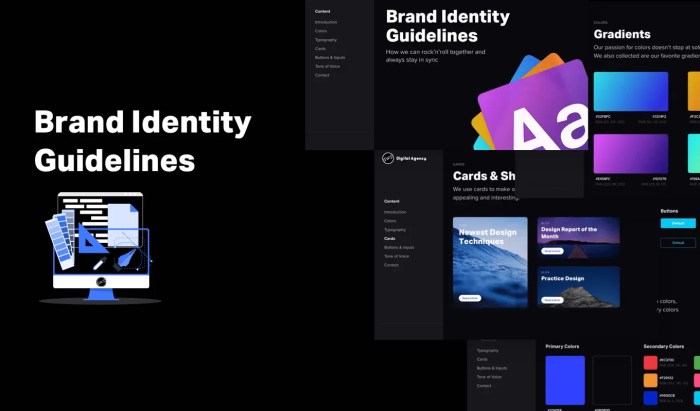Developing Brand Guidelines dives into the essence of creating a strong brand identity that resonates with the audience, exploring the key components and strategies essential for businesses to stand out in a crowded market.
From defining logo usage to maintaining consistency across various platforms, this guide delves deep into the world of brand guidelines and their impact on brand recognition and customer loyalty.
Importance of Developing Brand Guidelines
Developing brand guidelines is crucial for businesses to maintain consistency, build brand recognition, and establish a strong brand identity. It sets the tone for how a company presents itself to the world and ensures that all communications, designs, and messaging align with the brand’s values and mission.
Examples of Successful Implementation
- Apple: Known for its minimalist design and sleek products, Apple has successfully implemented brand guidelines that are reflected in every aspect of their brand, from their logo to their packaging.
- Nike: With its iconic swoosh logo and powerful tagline “Just Do It,” Nike has created a strong brand identity that resonates with customers worldwide.
- Coca-Cola: Coca-Cola’s consistent use of its signature red color, classic logo, and memorable advertising campaigns have solidified its position as a global brand.
Impact on Brand Recognition and Customer Loyalty
Strong brand guidelines play a crucial role in enhancing brand recognition and fostering customer loyalty. When customers consistently see a brand represented in a clear and cohesive manner, they are more likely to remember it and develop a sense of trust and familiarity with the brand. This, in turn, leads to increased customer loyalty, repeat business, and positive word-of-mouth referrals.
Components of Brand Guidelines

To create a strong and consistent brand identity, brand guidelines should include essential elements that serve as a reference for all marketing materials and communications.
Logo Usage
Logo guidelines specify how the logo should be used, including size, placement, spacing, and what variations are acceptable. Consistent logo usage helps in building brand recognition and credibility.
Color Schemes
Color palettes define the primary and secondary colors that should be used in all brand materials. Colors evoke emotions and play a crucial role in brand perception. For example, Coca-Cola’s red and white color scheme is instantly recognizable and associated with the brand.
Typography
Typography guidelines Artikel the fonts that should be used for headings, body text, and other design elements. Consistent typography helps in maintaining brand consistency and readability. For instance, the sleek and modern font used by Apple reflects the brand’s innovative and minimalist image.
Tone of Voice, Developing Brand Guidelines
Tone of voice guidelines define the brand’s personality and how it should communicate with its audience. Whether it’s friendly, professional, or humorous, a consistent tone of voice helps in creating a strong brand image. One example is the playful and irreverent tone used by Wendy’s on social media.
Imagery and Photography
Guidelines for imagery and photography establish the style and types of images that should be used in brand materials. Consistent visuals help in reinforcing brand identity and messaging. An example is the lifestyle-focused imagery used by Nike to convey a sense of empowerment and athleticism.
Creating Consistent Brand Identity
Maintaining a consistent brand identity across all platforms is crucial for building brand recognition and trust among consumers. Brand guidelines play a key role in ensuring that every communication, design element, and interaction with the brand reflects its core values and objectives.
Importance of Consistency
Consistency helps in reinforcing the brand image in the minds of customers, making it easier for them to identify and connect with the brand. It also builds credibility and trust, as consumers know what to expect from the brand at all times.
- Use the same color palette, typography, and logo across all marketing materials and platforms to create a cohesive brand image.
- Ensure that the tone of voice and messaging are consistent in all communications to maintain brand personality and values.
- Train employees and stakeholders on the brand guidelines to ensure that everyone is aligned and adhering to the set standards.
Designing Visual Assets
Visual assets such as logos, images, and graphics play a crucial role in conveying a brand’s identity. Designing these assets based on brand guidelines ensures consistency and strengthens brand recognition.
Process of Designing Visual Assets
When creating visual assets, designers refer to the brand guidelines to understand the color palette, typography, and overall aesthetic that represents the brand. They use these guidelines to craft logos, images, and graphics that align with the brand’s identity and values.
- Choose colors: Designers select colors from the brand’s color palette to maintain consistency across all visual assets.
- Typography: Fonts and typography styles are chosen carefully to reflect the brand’s tone and personality.
- Iconography: Icons and graphics are designed to complement the brand’s overall look and feel.
- Layout: Consistent layout principles are applied to ensure visual coherence across different assets.
Importance of Visual Consistency
Visual consistency in design reinforces brand identity by creating a cohesive and memorable brand experience for customers. When visual assets follow brand guidelines, they help build brand recognition and trust among consumers.
Examples of Successful Visual Asset Designs
One notable example of successful visual asset design following brand guidelines is the Nike Swoosh logo. Designed to represent movement and speed, the iconic logo has become synonymous with the brand and is easily recognizable worldwide. Another example is the Coca-Cola logo, which has remained consistent over the years, contributing to the brand’s enduring popularity and recognition.
Adapting Guidelines for Different Platforms: Developing Brand Guidelines

Adapting brand guidelines for various platforms is crucial in maintaining a consistent brand identity across different mediums. Whether it’s social media, print, websites, or any other platform, ensuring that your brand guidelines are flexible enough to adapt while still staying true to your brand is essential.
Strategies for Maintaining Brand Consistency
- Developing adaptable templates: Create templates that can be easily customized for different platforms while still reflecting your brand’s visual identity.
- Clear communication: Ensure that all team members involved in creating content across various platforms understand the brand guidelines and the importance of consistency.
- Regular audits: Conduct regular audits of all branding materials on different platforms to ensure they align with the established guidelines.
- Use of brand assets: Utilize consistent brand assets such as logos, color schemes, and fonts across all platforms to reinforce brand recognition.
Examples of Brands Implementing Consistent Guidelines
| Brand | Platforms | Consistency Strategy |
|---|---|---|
| Apple | Website, Social Media, Packaging | Consistent use of minimalist design, white space, and sleek imagery across all platforms. |
| Nike | Advertisements, Social Media, Retail Stores | Uniformity in using the swoosh logo, “Just Do It” slogan, and bold visuals to maintain brand identity. |
| Coca-Cola | Print Ads, Social Media, Packaging | Consistent use of red color, iconic logo, and messaging focusing on happiness and togetherness. |





